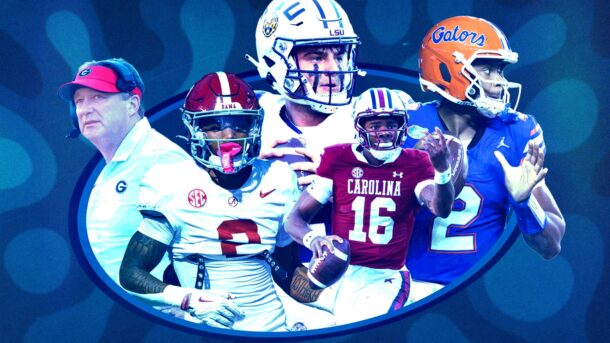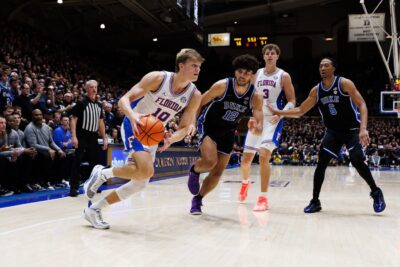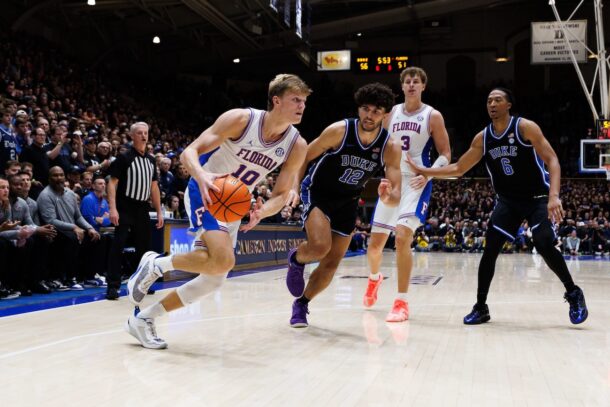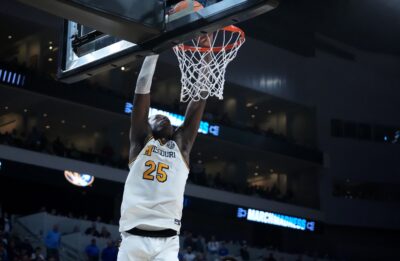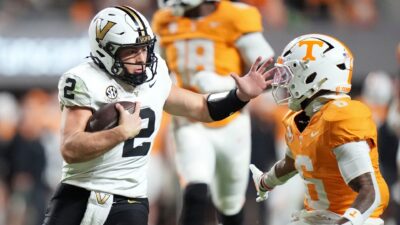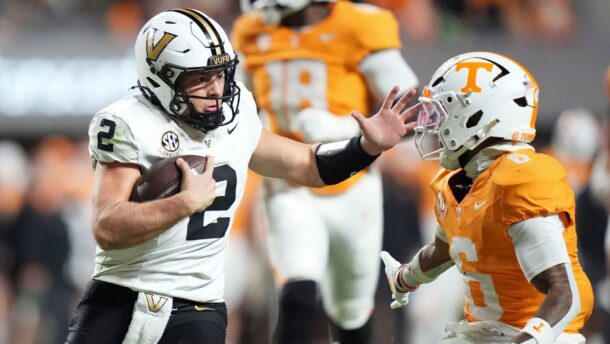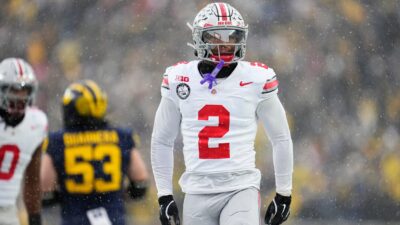SEC football is predicated on dominant play in the trenches, and it has been since its origins.
So it may surprise you to learn that among all the dominant offensive linemen to pass through the SEC on their way to the NFL, only six went on to be inducted into the Pro Football Hall of Fame. That’s right, only six.
The Hall of Fame is obviously an exclusive club, but there are far more than six offensive linemen in said club. Nevertheless, despite the dozens of former All-American offensive linemen who hailed from the SEC, six stood above the rest.
In honor of Offensive Line Week at SDS, let’s meet those men:
CENTER
Dermontti Dawson, Kentucky: Dawson is a Lexington, Ky., native who didn’t venture far to play his college football at the University of Kentucky, also located in Lexington. Dawson served as something of a hometown hero during his UK career. He lettered all four of his years as a Wildcat from 1984-87, and the Cats posted a cumulative record of 24-17 in those years, including a victory in the 1984 Hall of Fame bowl (perhaps some foreshadowing for Dawson, who was a freshman at the time).
Despite being repeatedly snubbed of all-conference honors (all he claimed in four years was a second-team All-SEC bid as a departing senior), Dawson still earned himself a spot in the NFL as a second-round selection by the Pittsburgh Steelers. He played his entire 13-year career in Pittsburgh, retiring in 2000 after reaching seven Pro Bowls and earning six All-Pro honors. Of the 184 games comprising Dawson’s illustrious career, he started 181 of them.
Dawson left a legacy significant to both the Steelers and the NFL. Although Pittsburgh has won more Super Bowls than any other franchise in history, leaving a legacy more decorated than any other football team in existence, Dawson still managed to stand out from the crowd of legends who came before him. He appeared in Super Bowl XXX but never played for a Super Bowl champion. Nevertheless, his number 63 was retired by the Steelers, who also named him to their All-Time Team. He was inducted into the Hall of Fame in 2012.
Frank Gatski, Auburn: Gatski was born and raised in the small town of Farmington, W.V., and like most of the men in his family, he spent most of his teenage years either attending school, playing football or working in the local mines. He played his high school ball on a cow pasture with no clock or scoreboard, but eventually earned a scholarship in 1940 to continue his football career at Marshall University in Huntington, W.V.
By the end of the 1942 season, Gatski has joined the Army Reserve and Marshall had shut down its football program in the midst of World War II. Gatski’s unit was called to fight in Europe, and when he returned from the war Marshall still didn’t have a team. So he completed his college football career at Auburn University, where he played the latter half of the 1945 season as a Tiger. He returned to the mines full-time after his college career ended, but when a former teammate at Marshall helped Gatski earn a tryout for the Cleveland Browns, Gatski hopped on a train to Bowling Green, Ohio, and never looked back.
He made the team at his tryout and was the starting center by his third year with the squad in 1948. He played the first 11 of his 12 NFL seasons for Cleveland, and played his final season for the Detroit Lions in 1957. It wasn’t until 1950 that the Browns latched on to the NFL, but by then Gatski and his crew were more than ready for the challenge. The star center is best known for snapping the ball to NFL legend Otto Graham for most of his career, and together they won three NFL Championships in 1950, 1954 and 1955 (his Detroit team also won it all in 1957).
Gatski was a four-time NFL champion, a four-time All-America Football Conference champion (the Browns’ home league until joining the NFL), a four-time Pro Bowler, a two-time All-Pro and a 1985 Hall of Fame inductee, closing the book on a legendary career with a legendary organization.
Dwight Stephenson, Alabama: Stephenson was born and raised in North Carolina, but wound up attending the University of Alabama on a football scholarship from 1976-79. During those four years he worked his way into Alabama’s starting lineup and eventually asserted himself as one of the stars of the team, helping the Tide post a 43-5 record in those four years including a 4-0 bowl record. Paul “Bear” Bryant, Alabama’s head coach during those years, once called Stephenson the best player he ever coached regardless of position, which should have tipped off the NFL regarding Stephenson’s special talent.
He was drafted in the second round of the 1980 NFL Draft by the Miami Dolphins, transitioning from one legendary head coach in Bryant to another in Miami’s Don Shula. Stephenson played his entire eight-year career in Miami from 1980-87, but didn’t break into the starting lineup until midway through the 1981 season. Once he did, however, his Dolphins’ lines established themselves among the best lines in NFL history, setting a league record by allowing the fewest sacks in the league for six straight seasons from 1982-87.
Stephenson was a five-time All-Pro, a five-time Pro Bowler and the 1985 recipient of the Walter Payton Man of the Year award for his work away from the field in the Miami community (he was also named the 2005 Walter Camp Man of the Year after retiring). He earned a spot on the NFL’s 1980s All-Decade team, and started at center in the Dolphins’ last two Super Bowl appearances in 1982 and 1984.
GUARD
John Hannah, Alabama: Hannah was born into an NFL family, following in the footsteps of his father, Herb Hannah, who played on the offensive line at Alabama and for the NFL’s New York Giants. John Hannah was born in Georgia, raised in Alabama and attended high school in Tennessee before eventually opting to play his college ball at Alabama like his father.
He played for Bryant at Alabama for three seasons from 1970-72, twice earning All-America honors including a consensus All-America honor as a senior in ’72. A stellar athlete, Hannah also participated in wrestling and the shot-put as a student-athlete at Alabama, and the university named him to its All-Century team by the end of the 1990s. Bryant once called Hannah the greatest linemen he ever coached, but he’d say the same of Stephenson less than a decade later, so make of that what you will. Nevertheless, Hannah was supremely talented and he proved Bryant right during his NFL career.
He was selected by the New England Patriots with the fourth overall pick of the 1973 draft, and he played all 13 of his pro seasons in New England. He was a 10-time All-Pro, a nine-time Pro Bowler, a four-time NFL Players Association Offensive Lineman of the Year, a member of the NFL’s All-Decade teams in both the 1970s and ’80s as well as a member of the league’s 75th Anniversary Team. His number 73 was retried by the Patriots, whom he led to one Super Bowl appearance but no championships. He’s a member of both the College Football and Pro Football Halls of Fame.
Gene Hickerson, Ole Miss: Hickerson was born and raised in Tennessee, but attended the University of Mississippi beginning in 1953 to play for legendary coach John Vaught. He played fullback in high school, but Vaught moved Hickerson to offensive tackle, beginning the career of one of college football and the NFL’s most historically significant limenen.
Hickerson used his athleticism in space as a former fullback and used it to be more effective as a blocker. He was named an All-American in 1957 and then went on to have 15-year NFL career, all with the Cleveland Browns, from 1958-73. He moved from tackle to guard in the NFL, and in a short time began doing things no other offensive lineman in the league could do.
Hickerson would pull from his guard spot and would lead his rushers down the field like a fullback, although he carried a guard’s wide frame, making him somewhat of a super-fullback (for lack of a better title). He wasn’t the first guard to pull to the outside and block in open space down field, but he did it better than anyone in history ever had. He led the way for three Hall of Fame tailbacks in Cleveland, most notably NFL legend Jim Brown.
He was a six-time Pro Bowler, a five-time All-Pro and a member of the NFL’s All-Decade team in the 1960s. He played in a whopping 202 career games and passed away in 2008, one year after earning his Hall of Fame induction.
TACKLE
Frank “Bruiser” Kinard, Ole Miss: Bruiser Kinard played at Ole Miss from 1935-37, leading the Rebels to their first-ever bowl appearance in the 1936 Orange Bowl. His teams were 18-13-3 during his three-year, 34-game career, and he earned All-Conference and All-America honors in both 1936 and 1937, becoming Ole Miss’ first All-American football player in history. He’s now a member of the Ole Miss Athletics Hall of Fame, the Mississippi Sports Hall of Fame and the Ole Miss Team of the Century.
He played nine seasons as a pro football star from 1938-47 and was a five-time Pro Bowler and a four-time All-Pro. He went on to serve as an assistant football coach and eventually as Athletics Director at Ole Miss following his pro career, and he’s now an inductee in both the College Football and Pro Football Halls of Fame.
A former newspaper reporter who has roamed the southeastern United States for years covering football and eating way too many barbecue ribs, if there is such a thing.
